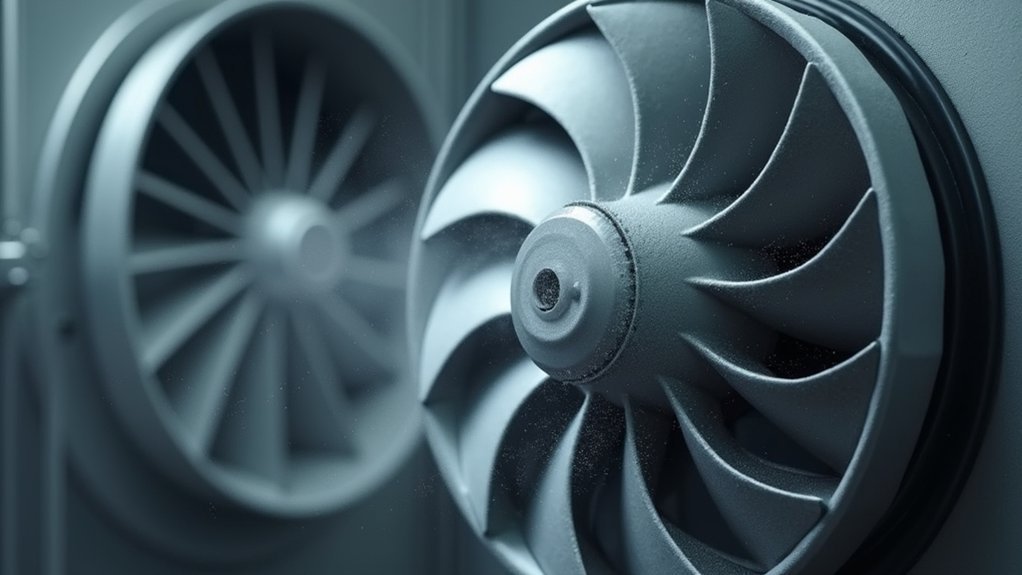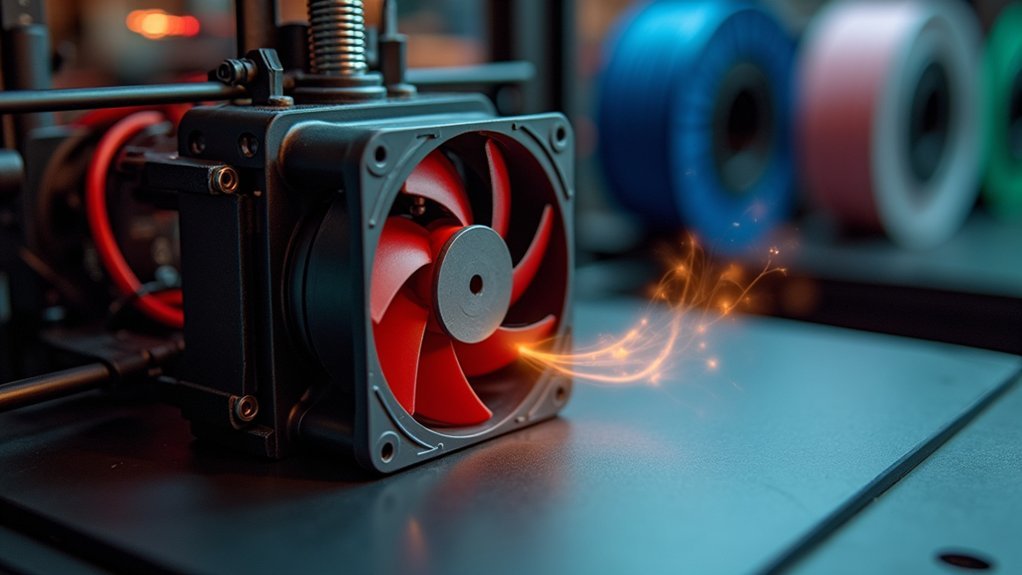You’ll achieve superior performance in high-pressure applications when you choose blower fans over axial fans, thanks to their centrifugal design that generates exceptional static pressure and maintains consistent airflow through complex ductwork systems. Blowers excel at directing targeted airflow to critical components, providing precise temperature control and up to 30% energy savings in demanding environments. While they require more complex installation and produce higher noise levels, their durability and effectiveness in confined spaces make them ideal for applications requiring reliable, high-pressure airflow. Understanding these key advantages will help you make the most informed decision for your specific cooling requirements.
Understanding Blower Fan Design and Airflow Mechanics

When you’re evaluating fan options for your application, understanding the fundamental design differences between blowers and axial fans becomes essential for making the right choice.
Blower fan design centers on specially shaped impeller blades that generate centrifugal force, enabling superior high pressure performance compared to axial fans operating at lower pressures. The airflow mechanics of a centrifugal blower direct air movement at right angles to the rotation axis, optimizing airflow efficiency through ductwork systems.
This design allows blowers to discharge high-pressure streams over long distances, while axial fans excel in low-pressure, high-volume applications. You’ll find that varying impeller shapes and sizes can be tailored to meet specific pressure and volume requirements for your particular needs.
Superior Static Pressure Performance in Confined Spaces
The superior airflow mechanics that define blower design translate directly into exceptional static pressure performance, particularly where space constraints challenge conventional fan systems. When you’re operating in confined spaces with complex ductwork, blowers maintain consistent airflow against high resistance while axial fans struggle under similar conditions.
| Performance Factor | Blowers | Axial Fans |
|---|---|---|
| Static Pressure | High pressure generation | Limited pressure capability |
| Confined Space Performance | Excellent air movement | Reduced efficiency |
| Resistance Handling | Maintains flow rates | Compromised performance |
You’ll find blowers excel in industrial applications requiring air movement through narrow ductwork or tight areas. Their impeller design creates a vortex effect that increases air pressure, enabling efficient operation in dust collection and fume extraction systems where space limitations demand superior static pressure capabilities.
Enhanced Heat Dissipation for 3D Printer Components

Because 3D printing demands precise temperature control across multiple components, blowers deliver targeted cooling that greatly outperforms axial fans in managing heat dissipation.
You’ll find that blowers’ perpendicular airflow design allows you to direct cooling precisely where it’s needed most—your hotend, stepper motors, and other critical components. This targeted approach prevents thermal issues that commonly cause print failures or quality degradation.
Unlike axial fans, blowers maintain higher static pressure, enabling effective airflow even in confined printer spaces.
You’ll achieve better reliability since blowers move air over longer distances, making them ideal for larger 3D printer setups. Their superior heat dissipation capabilities guarantee your components operate at ideal temperatures throughout extended printing sessions, reducing overheating risks and maintaining consistent performance.
Targeted Cooling for Print Quality Optimization
You’ll achieve superior print quality when you can precisely control where cooling occurs on your 3D prints.
Blowers excel at directing airflow exactly where it’s needed, maintaining consistent temperatures across complex geometries that would challenge traditional axial fans.
This targeted approach prevents hot spots and thermal variations that compromise your print’s structural integrity and surface finish.
Precision Heat Removal
When 3D printing demands flawless results, blowers deliver the precision heat removal that axial fans simply can’t match. Their superior static pressure enables targeted airflow that reaches critical components exactly where cooling’s needed most.
| Cooling Aspect | Blowers | Axial Fans |
|---|---|---|
| Airflow Direction | Highly focused and controllable | Broad, dispersed pattern |
| Static Pressure | High pressure for precise targeting | Lower pressure, less control |
| Heat Dissipation | Rapid, localized cooling | General area cooling |
| Temperature Control | Maintains consistent surface temps | Variable temperature zones |
| Manufacturing Processes | Enhanced for high-speed printing | Limited precision applications |
You’ll achieve superior print quality through blowers’ ability to eliminate thermal gradients and prevent warping. This precision cooling guarantees ideal adhesion while maintaining component integrity during demanding manufacturing processes, delivering consistently accurate results that axial fans can’t provide.
Consistent Print Temperature
Blowers maintain consistent print temperatures across your entire build platform while axial fans create unpredictable hot and cold zones that compromise print quality. Their superior static pressure guarantees uniform airflow distribution, eliminating the temperature fluctuations that cause warping and layer adhesion problems.
Unlike axial fans, blowers deliver consistent cooling performance that maintains ideal printing conditions throughout your entire build.
Here’s how blowers enhance temperature control:
- Higher static pressure creates uniform airflow patterns that eliminate hot spots across large print surfaces.
- Enhanced cooling efficiency through vortex effects reduces temperature variations between different print areas.
- Improved airflow rates at lower noise levels maintain stable thermal conditions without disrupting your workspace.
This consistent cooling dramatically reduces defects like warping and poor layer bonding, guaranteeing reliable print quality every time.
Overcoming Airflow Resistance in Duct Systems

Since ductwork creates significant resistance through friction, bends, and obstructions like filters, you need equipment that can maintain proper airflow under these challenging conditions.
Blowers excel at overcoming airflow resistance in duct systems through their centrifugal force design, which generates higher static pressure than axial fans. This capability guarantees efficient air movement even through long or complex ductwork configurations.
Unlike axial fans that struggle with increased resistance, blowers maintain consistent airflow rates and pressure throughout your system.
They’re specifically engineered to handle duct friction and multiple bends while delivering concentrated, directed air delivery.
When you’re dealing with high-resistance environments, blowers prevent the performance drops commonly experienced with axial fans, guaranteeing reliable operation regardless of system complexity.
Energy Efficiency Benefits in High-Pressure Applications
When you’re operating high-pressure systems, blowers deliver superior energy efficiency by maintaining consistent airflow where axial fans would struggle and consume excessive power.
You’ll achieve significant power consumption reduction because blowers use centrifugal force to generate higher static pressures with less energy input than comparable axial fan systems.
Your operational costs drop as blowers optimize airflow delivery in demanding applications without the energy penalties that axial fans experience under high-pressure conditions.
High-Pressure System Optimization
Although axial fans struggle to maintain performance under high-pressure conditions, blowers excel in these demanding environments by delivering superior energy efficiency where it matters most.
Their centrifugal design maintains consistent airflow through complex ductwork and against significant resistance, making them perfect for industrial cooling systems.
You’ll benefit from three key optimization advantages:
- Sustained static pressure performance – Blowers maintain efficiency even when pushing air through restrictive pathways
- Lower power consumption per volume – You’ll move more air while using less energy compared to axial fans at high pressure
- Reduced operational costs – Long-term energy savings offset initial investment through consistent performance
When your system demands reliable high-pressure airflow, blowers deliver the energy efficiency and performance consistency that axial fans simply can’t match.
Power Consumption Reduction
Three critical factors make blowers considerably more energy-efficient than axial fans in high-pressure applications. You’ll benefit from their centrifugal design that maintains superior airflow rates while consuming less power, especially when pushing air through restrictive ductwork. Energy-efficient blower motors operate effectively at lower RPMs, directly minimizing your electricity consumption during high-pressure air movement operations.
| Performance Factor | Blower Advantage |
|---|---|
| Energy Savings | Up to 30% reduction vs axial fans |
| Static Pressure | Superior performance against resistance |
| Airflow Volume | Higher rates with reduced power |
| RPM Requirements | Lower speeds for same output |
| Industrial Applications | Optimized for high-pressure systems |
You’ll reduce operational costs considerably since blowers deliver consistent air movement against resistance while maintaining lower energy consumption throughout their operational lifecycle.
Noise Considerations and Operational Differences
Since blowers operate at higher speeds with more complex impeller designs, they’ll generate notably more noise than axial fans in most applications.
You’ll need to weigh these noise considerations against operational differences when selecting equipment for your specific environment.
Blowers can exceed 85 dB in high-pressure applications, while axial fans typically produce 50-70 dB.
Blowers typically generate 85+ dB in demanding applications, significantly louder than axial fans’ 50-70 dB output range.
The perpendicular airflow from blowers creates abrupt directional changes that amplify noise levels compared to axial fans’ smooth, parallel airflow patterns.
Key operational differences include:
- Noise levels: Blowers produce notably higher decibel output due to turbulent airflow patterns
- Energy efficiency: Axial fans consume less power in low-pressure scenarios, reducing operational noise
- Environmental suitability: Axial fans work better in noise-sensitive areas like offices and residential spaces
Installation Requirements and Space Constraints
When planning your ventilation system layout, blowers demand considerably more installation requirements than their axial counterparts.
You’ll need extensive ductwork and additional support structures to handle the weight and operational demands of blower systems. The complex setup process requires careful consideration of airflow direction and duct layout, making installation more challenging than axial fans.
If you’re dealing with space constraints, axial fans offer significant advantages with their compact design.
They’re easily mounted in tight spaces and integrate seamlessly into existing systems without major modifications. While blowers provide superior pressure capabilities, their larger footprint and complex installation needs make them less suitable for environments where space is limited, requiring thorough planning before implementation.
Cost Analysis and Long-Term Performance Value
Although blowers require a higher initial investment than axial fans, you’ll find their superior pressure capabilities deliver exceptional value in demanding applications. When conducting a cost analysis, you’ll discover that blowers’ high-pressure output often eliminates the need for additional equipment, reducing overall operational costs despite higher energy consumption.
Consider these long-term performance benefits:
- Reduced Equipment Redundancy – Blowers’ powerful airflow eliminates multiple fan installations, lowering total cost of ownership.
- Enhanced Industrial Process Efficiency – Superior pressure delivery improves productivity and minimizes costly downtime.
- Strategic Maintenance Investment – While maintenance costs are initially higher, blowers’ durability in demanding environments reduces replacement frequency.
You’ll achieve better efficiency in applications requiring strong airflow over long distances, making blowers a smart investment for large-scale operations prioritizing long-term performance value.
Frequently Asked Questions
What Is the Difference Between Axial Fan and Blower?
You’ll find axial fans move air parallel to their rotation axis with high volume but low pressure, while blowers push air perpendicular to create higher pressure at lower flow rates.
Is a Blower Better Than a Fan?
You’ll find blowers aren’t universally better than fans – it depends on your specific needs. Choose blowers when you need high pressure and precise airflow through ductwork or restrictive systems.
What Are the Disadvantages of Axial Fans?
You’ll find axial fans generate more noise, struggle with high-pressure applications, spread dust and allergens, pose safety risks from blade breakage, and require larger installation spaces compared to alternatives.
Is an Axial Leaf Blower Better?
You’ll find axial leaf blowers excel at yard work with their high airflow, lightweight design, and portability. They’re more cost-effective than industrial blowers while offering ergonomic comfort for residential tasks.





Leave a Reply